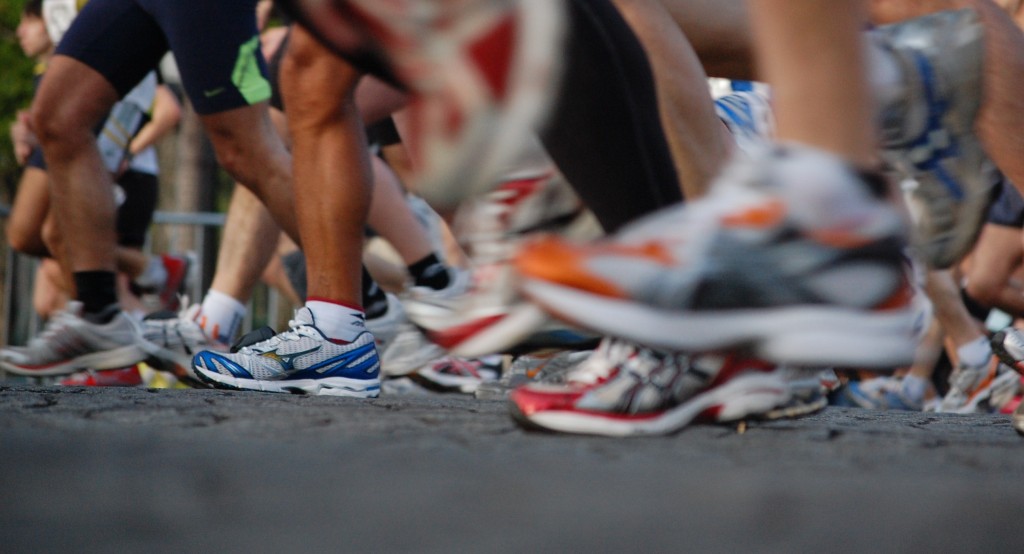When I started running cross-country in high school, my coach noticed something strange about my stride.
“You’re stomping your feet, Kane. Cut it out.”
While other runners on the team glided along nearly soundless as they raced through the trails, my feet pounded noisily. By the second week of practice, I noticed a pain in my shins and one of my knees started swelling up after each run. When I told my coach my issues, he wasn’t surprised.
“That’s what you get for stomping.”
Running is a high-impact sport, requiring its participants to smack their feet against hard surfaces for miles on end, sending the force from the impact through their ankles, knees and hips. Runners face plantar fasciitis, shin splints, inflammation of the Achilles tendon, and Runner’s Knee, where the cartilage on the kneecap wears down. According to the National Center for Biotechnology Information, between 37 and 56 percent of runners are injured every year.
For more than 30 years, runners were told that the solution was to run in orthotics, get surgery or give up running altogether. But a new approach is encouraging runners to throw out their old running shoes and run barefoot—or nearly so. There has been a massive increase in the popularity of minimalist running shoes, designed to mimic barefoot running while still protecting the bottom of the foot.
When we run, we are supposed to land on the balls of our feet where the network of tendons and bones help to disperse and absorb shock. But in the 1970s, shoe companies started changing their designs and made the heels of the shoes much larger, thinking that if people could land on their heels, they could increase their stride length. But not only were runners landing on their heel, they were hitting the ground harder, since their feet had to push through all the cushioning to land with any semblance of stability. Many researchers point to these as major factors in the wave of running injuries we see today.
Because the barefoot movement stresses the role of cushioned shoes in injury, people have started to see minimalist shoes as the solution to running injuries. The problem is that this way of thinking places too much emphasis on footwear and not enough focus on technique.
Baseball players practice throwing a baseball to avoid injuring their shoulders, and soccer players practice kicking so they don’t break their toes on the ball, but recreational runners don’t actively practice a healthy running technique.
Evolutionary biologists have shown us that humans were ‘born to run’ since we could walk upright, but our early ancestors didn’t lace up their Nikes before a run; they ran barefoot. Most modern runners grew up running in cushioned shoes, and our form adapted to the shoes’ presence mile after mile. While sustained use of minimalist shoes might help, one run in them won’t fix decades of incremental changes to our stride. In order to better avoid injury, runners need to actively fix their strides rather than throw out traditional shoes, as there is no evidence to suggest that the minimalist shoes prevent injury.
In fact, biologists say there is no evidence to suggest that any type of running shoes have ever helped runners avoid injury.
Daniel Lieberman, a professor of biological sciences at Harvard, has shown that practiced barefoot endurance runners typically land on the front part of their feet and land with less force than endurance runners in cushioned shoes, who usually land on the middle of their feet or on their heel. This second group of runners also reported a higher injury rate. The same trend is seen in Kenyan runners, who run barefoot until they are 17. These runners typically land on their forefoot and have highly elastic tendons in their feet and calves, allowing them to run more efficiently and with fewer injuries.
Because of this knowledge, many trainers and sports clinicians are becoming more particular about the shoes they suggest for younger children. Jay Dicharry, a physical therapist and the director of the SPEED sports clinic at the University of Virginia, suggests that children avoid wearing heavy, stiff shoes so their feet and stride can develop more naturally, like their Kenyan counterparts.
While barefoot running may be the most natural and efficient way to run, Lieberman and other researchers emphasize that you can still wear traditional shoes if you have a healthy running technique. Kenyan runners maintain their natural running form after making the transition to running shoes, and professional marathon and many ultra-marathon runners all depend on more traditional shoes during races, using barefoot training sessions to practice and maintain a correct stride. For healthy runners, technique takes precedence over footwear.
“Heels up, Kane.”







Part of the problem is that everyone’s foot is different so what works for someone may not work for another. Therefore, minimalist shoes can work for someone but it may not work for someone else. Thanks for the advice.